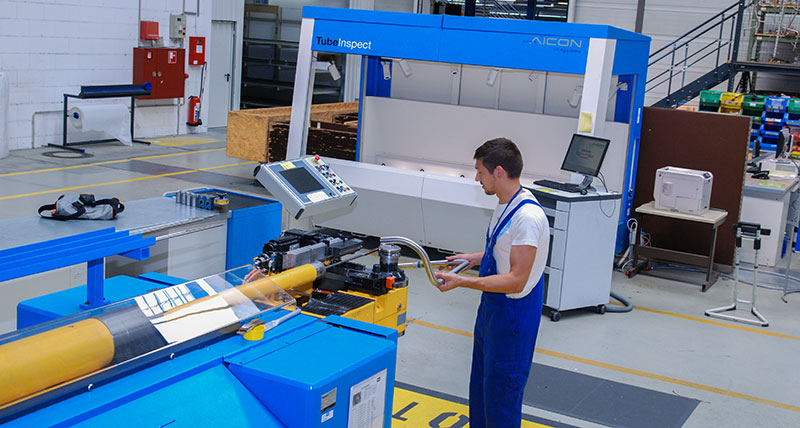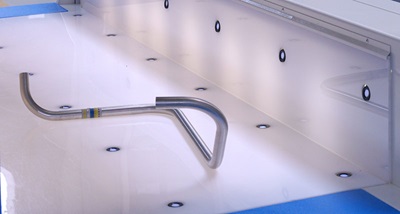TubeInspect in the aerospace industry
Test report documents suitability of TubeInspect for deployment in the aerospace industry
Contact us

Quality demands on tube manufacturing in the aerospace industry are considerably more stringent than in other industrial sectors. In order to determine the suitability of the optical tube measuring system TubeInspect for this sector, PFW Aerospace AG carried out an extensive measurement system analysis.
During the tests PFW Project Engineer Martin Seibt did not only identify the high repeatability of the system. Even the reproducibility was five times higher than one of the competing measuring systems. The test results have led to Airbus, a major customer of PFW, certifying the suitability of the TubeInspect measuring system for tube bends of over 7° and PFW has been given the official approval to deploy TubeInspect in production.
Special requirements in the aerospace industry
Tube manufacturing in the aerospace industry is much more complex than it appears at first glance. Highly developed systems constructed of bent tubes which are invisible from the outside run like veins through every modern aircraft - from the tip of the wing right to the landing gear. There are tube systems for example for fuel, hydraulic liquids, air and oxygen. Today, PFW Aerospace AG, with its headquarters in Speyer, Germany, and over 1500 employees worldwide, is considered to be a market leader in tube system manufacturing for the aerospace industry. EADS/Airbus, Boeing, Bombardier and Eurocopter are some of their renowned reference customers.
All tube systems are subject to strict quality regulations, as any imprecision could have disastrous consequences. Unbent tubes can only be obtained by explicitly qualified suppliers, who issue single parts with individual certifications. Accordingly, during further processing strict tolerance specifications have to be observed. At the PFW Aerospace AG the tube bending process has to fulfill highest demands in regards to perfect geometry.
In order to remain profitable however, the company has to be in a position to manufacture tubes in the smallest production batches with a minimal number of rejections. Martin Seibt, Project Engineer at PFW, explains why: "It is our aim to be able to manufacture profitably even for a production batch of just one unit as our customers often commission us to produce just one part. Take building a satellite as an example. A tube needed here is very unique and consequently a "one-off". So you commission PFW to produce just this one tube."
Even serial parts for aeroplanes can be ordered in quantities of less than ten pieces. Nearly without exception, production includes costly materials such as titan, stainless steel or Inconel, which is a non-corroding nickel-based alloy, and rejections have to be kept to a minimum. Martin Seibt comments: "Today PFW is in a position to immediately produce 20,000 components with minimal discard. More than two tubes being rejected before the first good unit would be an unacceptable cost factor for us."
 In the aerospace industry, where product diversity and the manufacturing of a large number of prototypes are required, a measuring system which can be employed universally is the ideal choice. Production methods such as manual gauges which have to be adjusted to fit each change of a tube and which have in addition to be stored for several years, no longer present an economic solution. To achieve more efficiency PFW analysed for the first time the potential of an optical measuring system and compared this with the tactile system which had been used to date for inspecting manufactured tubes.
In the aerospace industry, where product diversity and the manufacturing of a large number of prototypes are required, a measuring system which can be employed universally is the ideal choice. Production methods such as manual gauges which have to be adjusted to fit each change of a tube and which have in addition to be stored for several years, no longer present an economic solution. To achieve more efficiency PFW analysed for the first time the potential of an optical measuring system and compared this with the tactile system which had been used to date for inspecting manufactured tubes.
Tubing inspection with optical measurement
For the analysis, PFW chose AICON’s measuring system TubeInspect as this system is the only fully-optical measuring system on the market today which is specialized in bent tubes. TubeInspect carries out highly precise measurements of tube geometries by using high resolution digital cameras. Moreover it calculates the set-up and correction data and transfers these to the bending machines. The time needed for a tube inspection is short: For a fuel tube measuring data is available within 3 seconds, controlling a complex brake line with more than 40 bends can be carried out in less than 20 seconds. TubeInspect is capable of completely replacing cost-intensive mechanical gauges.
Analysis of measuring systems using two procedures
First procedure
To carry out the measurement system analysis PFW used two procedures representing latest technological standards. In the first test, which is the measurement capability test, the bias and the variance of the measuring system without any operator influence are evaluated according to a calibration master. An average, a standard deviation and a bias can be calculated from the measuring test sequence.
Carrying out a suitability test of a measuring system which represents the requirements of tube bending in the aerospace industry, PFW used the DKD-calibrated tube as a reference standard. This was measured 50 times, the tube was taken out of the measuring cell and replaced there for each following measuring. With these results Martin Seibt evaluated whether the measured values matched the established reference values of the calibrated tube and how the measurement results related to each other, i.e. how much the measuring results deviated.
Results of the first procedure: TubeInspect's variance is dramatically better than the variance of tactile system
The result was convincing: TubeInspect is suitable for the aerospace industry as a measuring system, as 99.7% of all the measured bending points differed less than 0.36mm (target value: 0.50mm) from the actual value. The repeatability was significantly better. The random error was ±0.09mm (3 Sigma), which is considerably less than the variance detected for the measuring method which was formerly used.
Martin Seibt evaluates the result as follows: "TubeInspect excels in optimal conditions due to its extremely low deviation. Compared with the competing system the precision is very good."
Second procedure
The second procedure is entitled Gage R&R-Study (Gage Repeatability & Reproducibility). This measuring procedure determines the repeatability and reproducibility of the measuring process in production conditions taking into account the influence of the operator. Depending on the results the decision is made whether the measuring process is suitable for the measuring task.
During the analysis both TubeInspect and the tactile system were used to measure four completely different tubes from four different machine setters with three different fixturing systems. In total 48 measurements per system were documented.
Results of second procedure: TubeInspect five times better than tactile system
Martin Seibt comments on the result of this examination: "We were surprised at the excellent performance of the TubeInspect system with regards to repeatability. AICON’s system performed five times better than the tactile measuring system. We realized that the setup of the tactile measurement based on a fixturing system manipulates the tube’s geometry - and this constitutes an enormous error source. TubeInspect works with an optical positioning assistant and every tube is measured in two positions. Due to this the system achieves significantly improved repeatability."
Conclusion
PFW presented these measurement results to Airbus, one of its most important customers. Due to the convincing results, PFW received from Airbus the official approval to deploy TubeInspect in production. The system is now implemented in the factory in Speyer and is used on a daily basis. Martin Seibt concludes: “AICON’s measuring system is the most contemporary technical method to fulfill the growing demands of the aerospace industry. Other manufacturers of measuring systems are encountering their technological limits. We are very satisfied with this purchase.”
